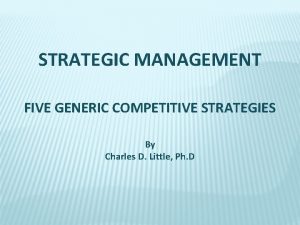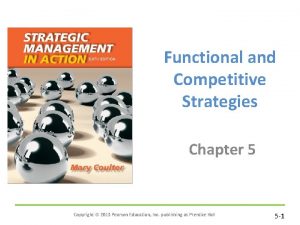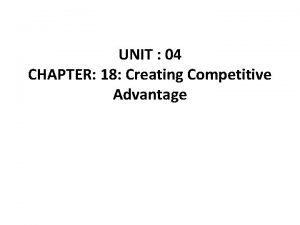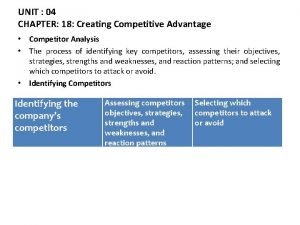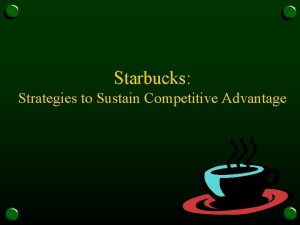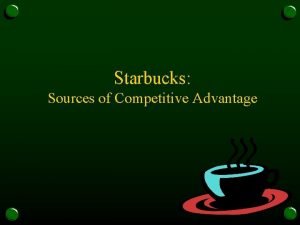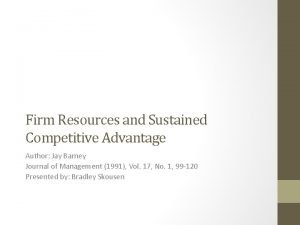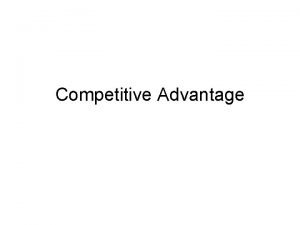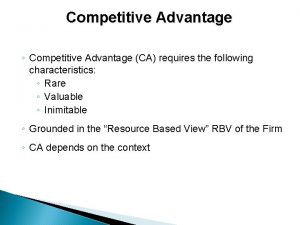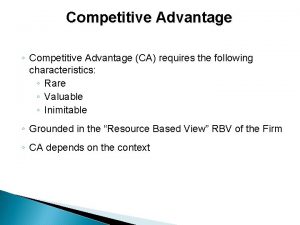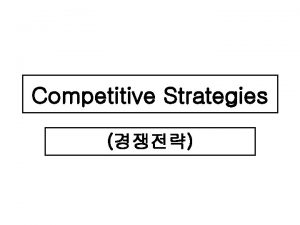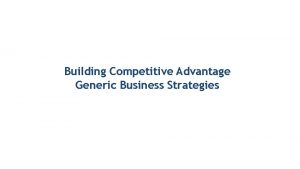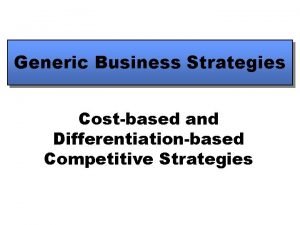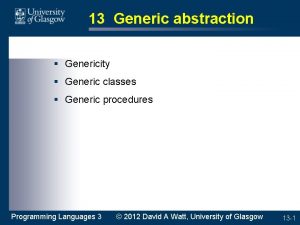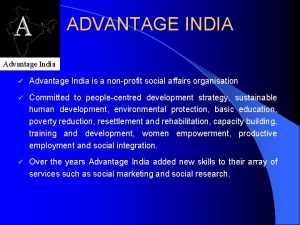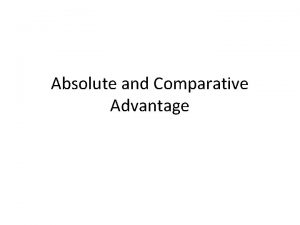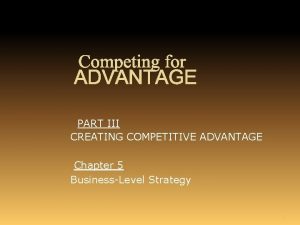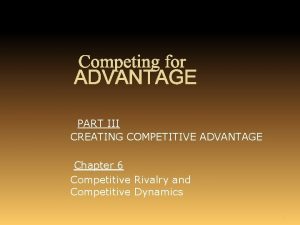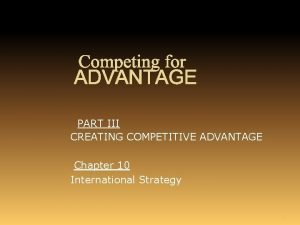Generic Strategies for Competitive Advantage The High Performance


















- Slides: 18

Generic Strategies for Competitive Advantage

The High Performance Business (Arthur D. Little, Inc 1992) Set strategies to satisfy key stakeholders… Stakeholders …by improving critical business processes… …and aligning resources and organization Processes Resources Organization

Sources of Profitability Profit = Revenue – Cost Revenue = Price x Volume • Increase revenues by increasing price • Lower cost and hold revenue constant • Increase revenue by increasing volume • Lower costs in excess of revenue losses • Increase revenue and hold cost constant • Lower costs and increase revenues (price increases) • Increase revenues in excess of cost increases Dr. Deshpande : Primer on Generic strategies 1

Understanding the Value Chain Firm Infrastructure Human Resource Management Support (Enabling) Technology Activities Development M a Procurement r g i n Inbound Logistics Operations Outbound Logistics Marketing & Sales After-Sales Service Primary (Core) Activities Dr. Deshpande : Primer on Generic strategies 2 Source: Michael Porter, Competitive Advantage, 1985

Levi Strauss’s Value. Delivery Network Du. Pont (Fibers) Order Delivery Milliken (Fabric) Order Delivery Competition is between networks, not Levi’s (Apparel) companies. The winner is the company with the better network. Order Delivery Sears (Retail) Order Delivery Customer

Generic Strategies “all men can see are the tactics by STRATEGIC ADVANTAGE which I conquer. . . what none can see is the strategy STRATEGIC TARGET from which it evolves. ” - Art of war Industry wide Uniqueness Perceived by the Customer DIFFERENTIATION Particular Segment only Dr. Deshpande : Primer on Generic strategies Low Cost Position OVERALL COST LEADERSHIP FOCUS 3 Source: Michael Porter, Competitive Strategy, 1980

Generic Strategies Cost Leadership Differentiation Focus Product Low High Low or High Differentiation (Principally by (Price or based on price) Uniqueness) Market Low High Low Segmentation (Mass Market) (Many (One of a few segments) key segments) Low High Low or High (Efficiency) (Value Added) (Efficiency or Cost Structure Value Added) Distinctive Manufacturing Research and Any kind of Competency and Materials Development, distinctive Management Marketing competency Dr. Deshpande : Primer on Generic strategies 4

Mixing low cost and differentiation Price $ Cost Industry average competitor Successful differentiated competitor Successful low-cost competitor Competitor with dual advantage Price per unit Cost per unit Dr. Deshpande : Primer on Generic strategies 5

Low cost player • This strategy involves striving to be the overall low cost provider of a product or service that appeals to a broad range of customers • It is a powerful strategy when the markets contains many price-sensitive buyers • The aim of this strategy is to open up a sustainable cost advantage over competitors and then use the company’s lower cost edge as a basis for either: - Under-pricing competitors and gaining market share (best choice if strong economies of scale are prevalent) - Selling at The “going rate” and earning a higher profit margin (low cost, therefore, does not always translate into a low price…. ) Dr. Deshpande : Primer on Generic strategies 7

To achieve a cost advantage, a firm’s cumulative costs across its value chain must be lower than their competitor’s cumulative costs Alternative methods to accomplish this: - Do a better job than rivals in performing value chain activities, and therefore lower their cost - Revamp the value chain to cut out some elements altogether (b/ward integration, f/ward integration; simplify product design; cut out all frills, features, options on the product) Dr. Deshpande : Primer on Generic strategies 8

When does low cost differentiation work Price competition in industry is very vigorous industry product is standardized -commodities There are few ways to achieve meaningful product differentiation-buyers are only sensitive to price differences Low or no switching costs are incurred by buyers Buyers are large, and have significant power to drive down prices Pitfalls of a low cost strategy ÞTechnological breakthroughs open up cost reductions for rivals ÞCost reduction strategy can be copied-advantage becomes short-lived and fixation on costs can cause failure to react to market changes (increased interest in new features) Dr. Deshpande : Primer on Generic strategies 9

Differentiation strategy The essence of this strategy is to be unique in ways that are valuable to the buyer, and • command a premium price that can be sustained for their product • sell more of their product at It is an attractive approach whenever the “going rate” and increase buyers needs are too diverse to be satisfied market share by a standardized product Dr. Deshpande : Primer on Generic strategies 10

Types of differentiation Signal differentiation • Different taste of product-Dr. Pepper • Special features- Trinitron Technology - • Buyers will not pay extra for value they don’t Sony perceive, no matter how real the unique extras • Superior service-Dell may be • Spare parts availability- Caterpillar • Actual and perceived value can differ • Engineering design and performance- whenever buyers have trouble assessing what Mercedes their experience with the product may be • Prestige and distinctiveness - Rolex • Product reliability-Johnson & Johnson • Incomplete knowledge from buyers often causes them to judge value based on signals • Technological leadership - 3 M • Full range of services-Merrill Lynch • Quality manufacture - Toyota Failure to signal value, where customers cannot adequately evaluate their potential experience with the product is a serious, and common cause of failure for differentiators Dr. Deshpande : Primer on Generic strategies 11

Differentiation and Impact on the five forces • Attempts to achieve differentiation usually raise costs • These costs must not be so high that they require a price most buyers are not willing to pay-or eat up all your Reduces rivalry between the firms when it enhances buyer loyalty - you don’t have to worry that your customers will leave you for your competitors New entrants are “blocked” because they cannot overcome the buyer loyalty you have developed expected returns Buyers have less power because no one can offer them a more attractive product-(loyalty, again) • You can only offer profitable “bells & Substitutes are not appealing-your product meets buyers needs “too” well (loyalty, again) whistles”-which requires a solid understanding of what the market really values, and how much they are willing to pay for it Powerful suppliers can raise prices, but your profit margins are protected-you can pass these costs on to your customers because they really want what you sell Dr. Deshpande : Primer on Generic strategies 12

When does it work ? There are many ways to differentiate a product or service and many buyers perceive these differences to have value Buyers needs and uses for your product are diverse Few rival firms are following a similar differentiation approach “Point” of differentiation cannot easily be copied by competitors What are the risks ? Þ Trying to differentiate on the basis of something that does not lower a buyer’s cost or enhance a buyer’s well-being- as perceived by the buyer Þ Over-differentiating so that the price is too high relative to competitors, or product quality or service levels exceed buyer needs Þ Trying to charge too high a price premium ignoring the need to signal value Þ Not understanding what buyers value Dr. Deshpande : Primer on Generic strategies 13

Focus strategy When it is costly or difficult for broad market players to meet the needs of the segment This strategy sets a focus on a narrow piece When no other rival is attempting to of the total market specialize in the market niche The target segment can be defined by: When the firm doesn’t have the resources to go after a wider part of the total market -geographic uniqueness -special product attributes that When the industry has many different appeal only to niche members segments, allowing the focuser to pick the one most suited to its strengths and capabilities Dr. Deshpande : Primer on Generic strategies 14

Focus attractiveness The segment is big enough to be profitable -the segment has good growth potential Focus examples The segment is not crucial to the success of • Rolls Royce major competitors • Omega - underwater watches • Rolex The focusing firm has the skills and • MUL - 800 for the physically resources necessary to serve the segment handicapped (low cost focus) The focuser can defend against challengers based on loyalty and the goodwill it has built Dr. Deshpande : Primer on Generic strategies 15

End of deck
 Four building blocks of competitive advantage
Four building blocks of competitive advantage 5 generic business strategies
5 generic business strategies Five generic competitive strategies examples
Five generic competitive strategies examples Porter's generic strategies
Porter's generic strategies Prospector strategy
Prospector strategy Market structure from most competitive to least competitive
Market structure from most competitive to least competitive Competitive antagonist
Competitive antagonist Competitive dynamics examples
Competitive dynamics examples Value creation strategy
Value creation strategy Chapter 18 creating competitive advantage
Chapter 18 creating competitive advantage Jay b barney
Jay b barney Competitive advantage starbucks
Competitive advantage starbucks What is starbucks competitive advantage
What is starbucks competitive advantage Human resource management gaining a competitive advantage
Human resource management gaining a competitive advantage Human resource management gaining a competitive advantage
Human resource management gaining a competitive advantage Human resource management gaining a competitive advantage
Human resource management gaining a competitive advantage Levi's competitive advantage
Levi's competitive advantage Firm resources and sustained competitive advantage
Firm resources and sustained competitive advantage Quotes on competitive advantage
Quotes on competitive advantage


